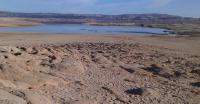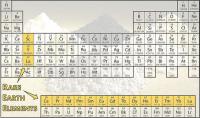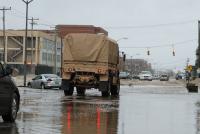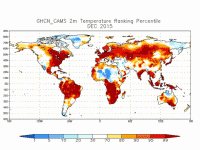-
New sensor rivals dogs in detecting explosives

Dogs have been used for decades to sniff out explosives, but now a University of Rhode Island scientist and his team have come up with another way to detect bombs: sensors. The scientist has developed a sensor that can detect explosives commonly used by terrorists. One of these explosives is triacetone triperoxide, or TATP. Triacetone triperoxide has been used by terrorists worldwide, from the 2001 “shoe bomber” Richard Reid to the suicide bombers who attacked residents of Paris in November. The explosive is relatively easy to make with chemicals that can be bought at pharmacies and hardware stores, attracting little attention from authorities.
-
-
Experts tackle U.K. flood risk
The U.K. Blue-Green Cities Research Project combines the expertise of academics from nine U.K. universities plus partners in the United States and China specializing in flood inundation modelling, computation fluid dynamics, sediment debris processes, river restoration and habitats, urban drainage infrastructure, environmental economics, uncertainty, flood risk management, and stakeholder engagement. The project’s goal is to make U.K. cities more resilient to flooding.
-
-
Integrating markets to offset climate-related food insecurity
Global market integration is key to buffering future commodity prices and food security from the negative effects of climate change on agriculture. Rising temperatures and an increase in extreme weather events will likely have adverse impacts on global crop production, leading to higher food prices and food scarcity. But global markets that have the ability to deliver food where it is needed most could help offset these consequences.
-
-
Extreme weather likely to result in “food shocks”
A panel of British and American researchers, speaking at the annual meeting of the American Association for the Advancement of Science (AAAS) in Washington, D.C., presented updated research revealing how extreme events which affect the food system are increasingly likely to occur, resulting in “food shocks.”
-
-
Students to learn coding - rather than a foreign language

Florida lawmakers are about the authorize a measure which would allow students to study computer coding instead of a foreign language. Florida is not the only state considering such a measure, as support for similar changes is growing across the United States. officials in Kentucky, Georgia, New Mexico, Oregon, and Washington have also considered substituting foreign language studies with computer coding credits.
-
-
Better Greenland, Antarctica sheet modeling helps predict sea-level rise
The Greenland and Antarctic ice sheets will make a dominant contribution to twenty-first century sea-level rise if current climate trends continue. However, predicting the expected loss of ice sheet mass is difficult due to the complexity of modeling ice sheet behavior. Better to understand this loss, a team of Sandia National Laboratories researchers has been improving the reliability and efficiency of computational models that describe ice sheet behavior and dynamics.
-
-
Passengers on trans-Atlantic flights will spend more time in the air as a result of climate change
Planes flying between Europe and North America will be spending more time in the air due to the effects of climate change, a new study has shown. By accelerating the jet stream — a high-altitude wind blowing from west to east across the Atlantic — climate change will speed up eastbound flights but slow down westbound flights, the study found. The findings could have implications for airlines, passengers, and airports.
-
-
Severe drought no longer caused just by nature

Scientists are calling on drought researchers and managers around the world to consider both human activity and natural phenomena in their battle to preserve increasingly scarce global water supplies. The experts say that severe droughts experienced recently in countries such as China, Brazil and the United States can no longer be seen as purely natural hazards. Changes to the way people use the water and the landscape contribute to extreme water shortages.
-
-
Extracting rare-earth elements from coal could soon be economical in U.S.

The United States could soon decrease its dependence on importing valuable rare-earth elements (REEs) which are widely used in many industries, according to a team of researchers. who found a cost-effective and environmentally friendly way to extract these metals from coal byproducts.
-
-
Calls for banning Muslims from entering U.S. impractical, harmful: Expert

Duke sociologist Christopher Bail, who studies how anti-Muslim organizations use social media, says that calls to ban immigration of Muslims to the United States are missing two important points. First, there is no conceivable mechanism whereby the United States could identify Muslims — short of visual cues such as headdress or religious garb, which are not worn by most Muslims. Second, and perhaps more importantly, it is surprising that people think that groups such as ISIS could not disguise terrorists they want to send to the United States as non-Muslims.
-
-
Tools to help communities predict, cope with floods

Anticipation and preparedness of large-scale flood events play a key role in mitigating their impacts and optimizing the strategic planning of water resources. Although many countries have well-established systems for river monitoring and early flood warning, an increasing number of inhabitants are affected by floods every year. The Global Flood Awareness System (GloFAS) has been set up providing an overview on upcoming flooding in large world river basins.
-
-
Human-induced climate change helped cause south of England floods: Scientists
Human-induced climate change increased the risk of severe storms like those that hit the south of England in the winter of 2013-14, causing devastating flooding and costing several people their lives. This is according to new analysis from an international team of climate scientists led by researchers at Oxford University.
-
-
Recent summer temperatures in Europe likely the warmest of the last 2 millennia

Most of Europe has experienced strong summer warming over the course of the past several decades, accompanied by severe heat waves in 2003, 2010, and 2015. New research now puts the current warmth in a 2,100-year historical context. The evidence suggests that past variability has been associated with large volcanic eruptions and changes in the amount of energy received from the sun, but that temperatures over the past thirty years lie outside the range of these natural variations, supporting the conclusion that recent warming is mainly caused by anthropogenic activity.
-
-
Boko Haram attacks force more than 1 million children from school in northeastern Nigeria

Violence and attacks against civilian populations in northeastern Nigeria and its neighboring countries have forced more than one million children out of school, UNICEF said on Tuesday. The number of children missing out on their education due to the conflict adds to the estimated eleven million children of primary school age who were already out of school in Nigeria, Cameroon, Chad, and Niger before the onset of the crisis. Across Nigeria, Cameroon, Chad, and Niger, over 2,000 schools remain closed due to attacks by Islamist group Boko Haram and the military campaign conducted against it — some of these schools for more than a year — and hundreds have been attacked, looted, or set on fire.
-
-
Predicting political surprises, uprisings before they happen
From the Arab Spring to the successful leadership bid by Jeremy Corbyn or Donald Trump’s success in the U.S. Republican campaign: Why are so many surprising things happening in politics? New research has harnessed a wealth of digital data and techniques to try to answer this question.
-
More headlines
The long view
New Technology is Keeping the Skies Safe
DHS S&T Baggage, Cargo, and People Screening (BCP) Program develops state-of-the-art screening solutions to help secure airspace, communities, and borders
Factories First: Winning the Drone War Before It Starts
Wars are won by factories before they are won on the battlefield,Martin C. Feldmann writes, noting that the United States lacks the manufacturing depth for the coming drone age. Rectifying this situation “will take far more than procurement tweaks,” Feldmann writes. “It demands a national-level, wartime-scale industrial mobilization.”
How Artificial General Intelligence Could Affect the Rise and Fall of Nations
Visions for potential AGI futures: A new report from RAND aims to stimulate thinking among policymakers about possible impacts of the development of artificial general intelligence (AGI) on geopolitics and the world order.
Smaller Nuclear Reactors Spark Renewed Interest in a Once-Shunned Energy Source
In the past two years, half the states have taken action to promote nuclear power, from creating nuclear task forces to integrating nuclear into long-term energy plans.
Keeping the Lights on with Nuclear Waste: Radiochemistry Transforms Nuclear Waste into Strategic Materials
How UNLV radiochemistry is pioneering the future of energy in the Southwest by salvaging strategic materials from nuclear dumps –and making it safe.
Model Predicts Long-Term Effects of Nuclear Waste on Underground Disposal Systems
The simulations matched results from an underground lab experiment in Switzerland, suggesting modeling could be used to validate the safety of nuclear disposal sites.
